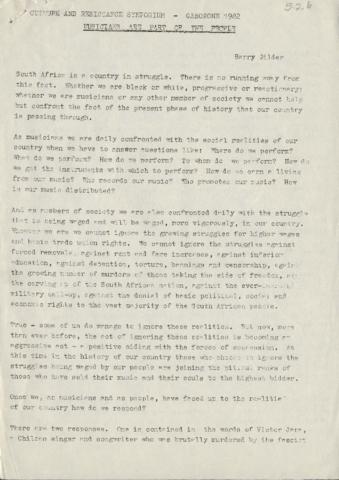Identity area
Reference code
Title
Date(s)
- 1982 (Creation)
Level of description
Subseries
Extent and medium
4 pages
Context area
Name of creator
Administrative history
The Medu Art Ensemble was formed by South Africa exiles in Gaborone, Botswana, in 1978. The organisation produced a wealth of creative work across all major art-forms; the roup further played a key role in shaping aesthetic and cultural theory and praxis within Africanist and liberation struggles. On June 14 1985, the South African Defence Force attacked the homes of Medu members and other activists in Gaborone, killing 12 people; Medu as an organisation ceased to exist.
Name of creator
Biographical history
Repository
Archival history
Immediate source of acquisition or transfer
Content and structure area
Scope and content
In this paper, Barry Gilder argues that it is impossible for musicians to be separate from the struggle against Apartheid in South Africa. He suggests that musicians have two options; to be part of the struggle against Apartheid as "revolutionaries who make music" or as musicians who participate in the "revolution as musicians". Musicians can fight Apartheid through holding benefit concerts, creating their own record labels, organising into a collective musical organisation and boycotting the Apartheid state. These methods of resistance and artistic expression, the author argues, will all contribute to a necessary and genuinely popular and progressive musical culture.
Appraisal, destruction and scheduling
Accruals
System of arrangement
Conditions of access and use area
Conditions governing access
Conditions governing reproduction
Permission to publish must be obtained from the Medu Art Ensemble Project.
Language of material
Script of material
Language and script notes
Physical characteristics and technical requirements
Finding aids
Allied materials area
Existence and location of originals
Existence and location of copies
Related units of description
Notes area
Note
The article has a duplicate.


